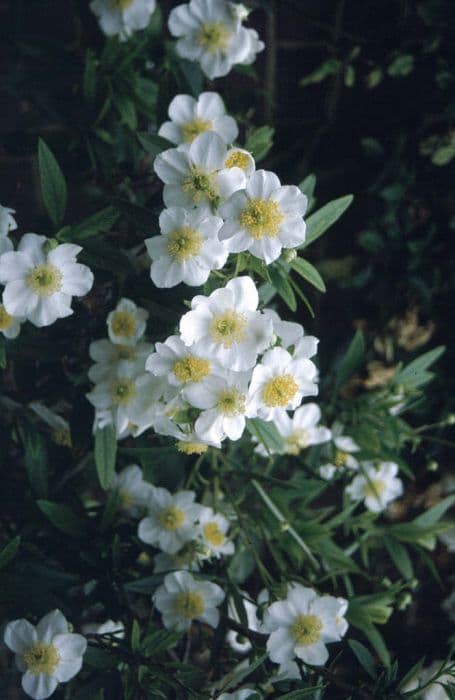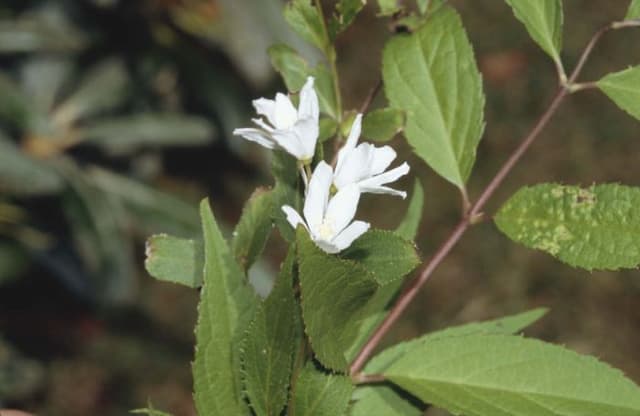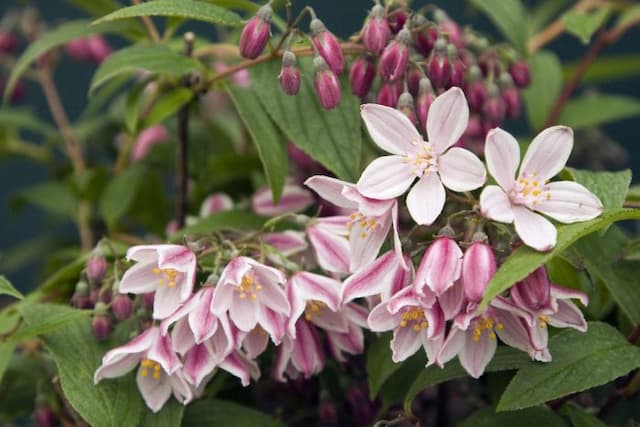Hydrangea macrophylla 'Hanabi' (L/d)

ABOUT
The Hydrangea macrophylla 'Hanabi', commonly known as the 'Hanabi' lacecap hydrangea, is a unique variety known for its distinctive and ornate flowers. The name 'Hanabi' translates to 'fireworks' in Japanese, which is a fitting descriptor for the visual explosion of blooms this plant produces. These flowers typically consist of a flat-topped cluster with small, tightly packed, bud-like blooms at the center surrounded by a ring of larger and more showy sterile flowers that resemble stars bursting in the air. The color of the flowers can vary widely depending on the soil pH, ranging from blue in acidic soils to pink in alkaline soils, with shades of purple or mixed colors often found in soils with pH levels in between. The leaves of this hydrangea are ovate with serrated edges, and they have a glossy, deep green color that provides a beautiful contrast to the vibrant flowers. The plant exhibits a bushy habit, with multiple stems branching out and creating a rounded shape that serves as a lush backdrop for the profusion of blooms which emerge in the summer. Its overall appearance when in full bloom is eye-catching and can be quite a spectacle, reminiscent of a brilliant display of fireworks.
About this plant
 Names
NamesFamily
Hydrangeaceae.
Synonyms
Bigleaf Hydrangea, French Hydrangea, Lacecap Hydrangea, Florist's Hydrangea, Garden Hydrangea, Penny Mac, Hortensia.
Common names
Hydrangea macrophylla (Thunb.) Ser.
 Toxicity
ToxicityTo humans
Bigleaf hydrangea is considered to have low toxicity to humans. Ingesting any part of the plant can lead to gastrointestinal upset, with symptoms such as vomiting, stomach pain, and diarrhea. It is best to avoid consuming this plant.
To pets
Bigleaf hydrangea is toxic to pets, including dogs and cats. The plant contains compounds called cyanogenic glycosides, which can release cyanide when chewed or digested. Symptoms of poisoning may include vomiting, diarrhea, depression, and in severe cases, more serious symptoms like difficulty breathing and increased heart rate could occur. If you suspect your pet has ingested part of this plant, contact your veterinarian.
 Characteristics
CharacteristicsLife cycle
Perennials
Foliage type
Deciduous
Color of leaves
Green
Flower color
Varies
Height
4-6 feet (1.2-1.8 meters)
Spread
4-6 feet (1.2-1.8 meters)
Plant type
Shrub
Hardiness zones
5-9
Native area
Japan
Benefits
 General Benefits
General Benefits- Aesthetic Appeal: Hydrangea macrophylla 'Hanabi' offers large, showy flowers that bloom in various colors depending on the soil pH, which can enhance the visual appeal of any garden.
- Extended Blooming Season: The plant typically blooms from early summer to late fall, providing a long-lasting display of flowers.
- Easy to Grow: This variety of hydrangea is known for being hardy and relatively easy to care for, making it a good choice for both new and experienced gardeners.
- Versatility in Landscaping: It can be used in a variety of landscape designs, ranging from mass plantings to specimen or focal points.
- Attracts Pollinators: The flowers of Hydrangea macrophylla 'Hanabi' attract butterflies and bees, contributing to the pollination of plants and overall garden health.
- Drought Tolerance: Once established, this hydrangea can be relatively drought-tolerant, reducing the need for frequent watering.
- Seasonal Interest: The plant adds interest to the garden in multiple seasons, with the ability to retain dried flower heads during winter that provide textural interest.
- Pruning Flexibility: It can be pruned after blooming to control the size and shape or to promote more vigorous growth and larger flowers.
- Cut Flower Usage: The flowers are suitable for cutting and including in floral arrangements, with the ability to hold their color and structure well when cut.
- Shade Tolerance: Hydrangea macrophylla 'Hanabi' can tolerate partial shade, offering a flowering option for less sunny areas of the garden.
 Medical Properties
Medical PropertiesThis plant is not used for medical purposes.
 Air-purifying Qualities
Air-purifying QualitiesThis plant is not specifically known for air purifying qualities.
 Other Uses
Other Uses- Hydrangea macrophylla 'Hanabi' can be used in the art of flower pressing due to its broad, colorful petals that retain color well when dried.
- The vibrant flowers are often used in photography and painting as a subject for still life compositions, providing inspiring color palettes.
- The plant can serve as a pH indicator because the flower color changes in response to the soil's pH level, making it handy for gardeners experimenting with soil chemistry.
- In crafting, the dried blooms of the hydrangea can be incorporated into wreaths, ornaments, or other decorative items.
- Hydrangea petals can be used in eco-printing, a technique where plants are used to transfer colors and patterns onto fabric or paper.
- The stems are sometimes used in basket weaving for decorative purposes as their flexibility allows for intricate weaving when soaked.
- During festive seasons such as Easter, the bright flowers are used to create natural dyes for coloring eggs.
- Because of their full and lush blooms, hydrangeas are often used as natural confetti at outdoor celebrations, especially garden weddings.
- The dried flower heads can be turned into potpourri, combined with other herbs and spices, to create a delightful room fragrance.
- Culinary artists sometimes use the blooms as a natural garnish for desserts and drinks, despite the plant not being edible; caution is advised as parts of hydrangea plants are toxic when ingested.
Interesting Facts
 Feng Shui
Feng ShuiThe Hydrangea is not used in Feng Shui practice.
 Zodiac Sign Compitability
Zodiac Sign CompitabilityThe Hydrangea is not used in astrology practice.
 Plant Symbolism
Plant Symbolism- Heartfelt Emotions: The lush blooms of the Hydrangea macrophylla 'Hanabi', commonly known as the Hydrangea, often represent deep and heartfelt emotions such as gratitude, understanding, and apology, thanks to their abundant and spherical flower heads which are reminiscent of a full heart.
- Gratitude: Hydrangeas are sometimes given as a thank-you gesture, symbolizing sincerest gratitude due to their voluminous and generous appearance, suggesting an overflowing abundance of feelings.
- Apology: In Japan, hydrangeas have been associated with apologies and repentance. This is attributed to a legend where an emperor used them to apologize to a girl he loved after neglecting her in favor of business and showing gratitude for her loyal support.
- Vanity: Some Victorian interpretations consider the hydrangea a symbol of vanity and boastfulness, possibly due to their showy and ornate flowers that appear almost boastful in their display.
- Frigidity or Dispassion: Due to its origins in a Japanese legend, a sentiment of coldness or lack of romantic interest can sometimes be conveyed through the gift of hydrangeas, making them a complex symbol with both positive and negative connotations depending on cultural context.
- Abundance: The voluminous clusters of flowers on hydrangeas can also stand for abundance and prosperity, making them fitting gifts for housewarmings or celebrations that mark life's bountiful moments.
 Water
WaterBigleaf hydrangeas, such as 'Hanabi', typically require consistent moisture and prefer soil that is moist but well-draining. During the growing season, water your 'Hanabi' hydrangea once or twice a week, providing about 1 inch of water each time. This may translate to around 0.623 gallons for a standard-sized plant in an outdoor garden setting. However, watering frequency should be adjusted based on weather conditions; less water is necessary during rainy periods or in cooler temperatures, while more may be needed in intense heat. Always water the soil directly rather than the foliage to prevent fungal diseases, and ensure the soil is damp to a depth of several inches after watering.
 Light
LightBigleaf hydrangeas, such as 'Hanabi', thrive best in partial shade. They benefit from morning sun and afternoon shade or filtered sunlight throughout the day, which allows them to produce abundant blooms without the stress of intense midday sun. The ideal spot for a 'Hanabi' hydrangea is an area that gets bright, indirect light and protection from the harsh direct sunlight of the afternoon.
 Temperature
TemperatureBigleaf hydrangeas like 'Hanabi' prefer temperatures that stay consistently between 60°F and 75°F. They can endure temperatures as low as 50°F and as high as 80°F, but temperatures outside this range could stress the plant or potentially cause damage. Ideal growing conditions for a 'Hanabi' hydrangea are moderate, avoiding extremes of heat or cold.
 Pruning
PruningBigleaf hydrangeas like 'Hanabi' benefit from pruning to remove dead wood and encourage fresh growth and better flowering. Prune in late winter or early spring, before new growth begins, as 'Hanabi' blooms on old wood. Remove any dead or broken branches, and if the plant is older, prune out a few of the oldest stems to rejuvenate it. Pruning every year is not necessary; every other year or when the plant looks untidy is generally sufficient.
 Cleaning
CleaningAs needed
 Soil
SoilThe best soil mix for Hydrangea, commonly known as mophead hydrangea, includes a combination of loamy soil, well-rotted compost, and coarse sand or perlite to ensure good drainage and aeration. The pH should be acidic to slightly acidic, around 5.2 to 5.5 for blue flowers, and more neutral, around 6.0 to 6.5, for pink flowers.
 Repotting
RepottingMophead hydrangeas should be repotted once they become root-bound or every 2 to 3 years to refresh the soil. It is best to repot in late winter or early spring before new growth begins.
 Humidity & Misting
Humidity & MistingMophead hydrangeas prefer high humidity levels, ideally between 60% to 70%. If indoor air is too dry, use a humidifier or mist the leaves regularly to maintain the best humidity conditions for the plant.
 Suitable locations
Suitable locationsIndoor
Keep in bright, indirect light and maintain high humidity.
Outdoor
Plant in part-shade, moist, well-draining soil.
Hardiness zone
6-9 USDA
 Life cycle
Life cycle'Hanabi' hydrangea begins its life cycle when a seed germinates, typically in spring, growing into a young seedling. The seedling then develops into a vegetative plant, producing robust leaves and a woody stem over time. In subsequent years, as a mature plant, it enters a phase of perennial growth, where it undergoes periods of dormancy in the winter and re-emerges in the spring. During the summer growing season, 'Hanabi' hydrangea produces large, showy flower clusters known as inflorescences, which can vary in color based on soil pH. After pollination, if successful, the flowers produce seeds, completing the reproductive cycle. Over many years, the plant continues to grow larger and produce more flowers, until it eventually reaches the end of its lifespan and dies.
 Propogation
PropogationPropogation time
Spring to Summer
The most popular method of propagation for the Hydrangea macrophylla 'Hanabi', commonly known as the Lacecap Hydrangea, is through softwood cuttings usually taken in late spring to early summer. This involves cutting a 4 to 6-inch (10 to 15 cm) piece of new growth, ideally with several pairs of leaves. The lower leaves are removed, and the cut end is dipped in rooting hormone powder to encourage root development. The cutting is then placed in a well-draining potting mix, ensuring that at least one set of leaf nodes is below the surface. The pot is kept in a warm, humid environment, often covered with a plastic bag or placed in a propagator to maintain humidity, until new growth indicates that rooting has occurred, which typically takes a few weeks.








![Hydrangea [Strong Annabelle]](/_next/image?url=https%3A%2F%2Fplants-admin.emdemapps.com%2Fimages%2Fplants%2F%2Fimages%2F604b54db37d34.png&w=640&q=75)
